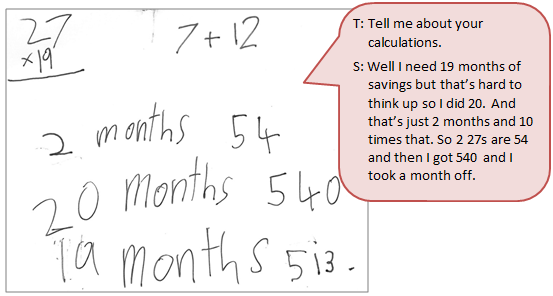The purpose of this activity is to engage students in using their number knowledge and skills to solve a problem requiring partitioning.
This activity assumes the students have experience in the following areas:
- Recalling basic addition and subtraction facts.
- Multiplying and dividing whole numbers.
- Interpreting a calendar.
The problem is sufficiently open ended to allow the students freedom of choice in their approach. It may be scaffolded with guidance that leads to a solution, and/or the students might be given the opportunity to solve the problem independently.
The example responses at the end of the resource give an indication of the kind of response to expect from students who approach the problem in particular ways.

Bill puts exactly $27 into his piggy bank every month.
It takes one year and seven months to fill. How much money will Bill have in his full piggy bank?
The following prompts illustrate how this activity can be structured around the phases of the Mathematics Investigation Cycle.
Make sense
Introduce the problem. Allow students time to read it and discuss in pairs or small groups.
- Do I understand the situation and the words? (Students may not be familiar with saving in a piggy bank.)
- What are the important words and symbols? (Knowing that 1 year has 12 months is important.)
- What will my solution look like? (The solution will give the total amount saved by Bill, supported by calculations.)
Plan approach
Discuss ideas about how to solve the problem. Emphasise that, in the planning phase, you want students to say how they would solve the problem, not to actually solve it.
- What are the maths skills I need to work this out? (Students should recognise the need to understand years and months, and that multiplication will be applied.)
- How could I show this problem using numbers, pictures, graphs, tables, or materials?
- What could the solution be? What is a sensible estimate?
- What tools (digital or physical) could help my investigation?
Take action
Allow students time to work through their strategy and find a solution to the problem.
- Is my strategy working? Is there a more efficient way to solve the problem? (Note the preferencing of multiplication instead of repeated addition.)
- Have I recorded my ideas in a way that helps me to see patterns? (Sequences of equations that are systematic will reveal patterns involving multiplication.)
- Are there any patterns?
- How might I describe the pattern?
- Does my answer seem correct? Is it close to my estimation?
- How could I make sure that I haven’t missed anything?
- Does my solution answer the question?
- Is there another possible way to solve it?
Convince yourself and others
Allow students time to check their answers and then either have them pair share with other groups or ask for volunteers to share their solution with the class.
- What is the solution? It my solution clear?
- Is my working clear for someone else to follow?
- How would I convince someone else I am correct? Have I justified what I did?
- Could I have solved the problem in a more efficient way?
- Is my strategy suitable for other problems? What kinds of problems is it suitable for?
- What maths have I used to solve the problem, including knowledge and strategy?
Examples of work
Work sample 1
The student combines additive and multiplicative thinking to solve the problem.
Click on the image to enlarge it. Click again to close.
Work sample 2
The student applies the distributive property of whole numbers under multiplication to solve the problem. They round the multiplier and adjust the product correctly.

